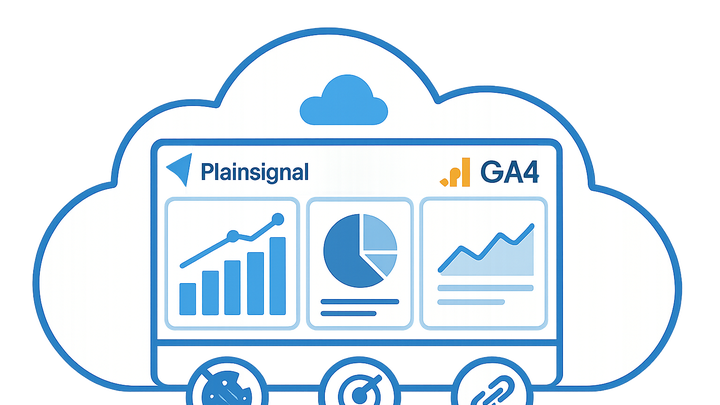Published on 2025-06-22T05:21:11Z
What is SaaS Analytics? Examples and Best Practices
SaaS Analytics refers to cloud-based platforms that enable organizations to collect, process, and visualize data through a subscription model. These tools remove the burden of managing servers and infrastructure, offering scalability, automatic updates, and secure data handling. Teams gain access to customizable dashboards, real-time reporting, and integrations with marketing, sales, and product tools. Examples include PlainSignal, which provides a simple, cookie-free approach, and Google Analytics 4 (GA4), which offers an event-driven model and advanced machine-learning insights. Typically, implementing a SaaS analytics solution involves inserting a small snippet of JavaScript into your website or application, granting immediate access to user behavior and business metrics. By leveraging SaaS analytics, businesses can focus on deriving insights and driving growth rather than maintaining backend systems.
Saas analytics
Cloud-based analytics platforms (like PlainSignal and GA4) for scalable data collection, real-time reporting, and customizable dashboards.
Why SaaS Analytics Matters
SaaS analytics solutions offer numerous advantages over traditional on-premise tools. They provide elastic scalability, making it easy to handle spikes in data volume without manual provisioning. Automatic updates and vendor-managed infrastructure free teams from maintenance tasks. Subscription-based pricing converts large upfront investments into predictable operational expenses. Lastly, the accessibility of cloud platforms ensures that stakeholders can access insights from anywhere, at any time.
-
Scalability
SaaS platforms automatically allocate resources to handle increasing data loads, ensuring performance remains consistent as your business grows.
-
Accessibility
Users can log in from any device with an internet connection, enabling teams to collaborate and access reports in real time.
-
Cost efficiency
The subscription model eliminates large upfront infrastructure costs and provides predictable, pay-as-you-go pricing.
-
Automatic updates
Platform updates and security patches are managed by the vendor, ensuring you always have access to the latest features without downtime.
Key Features of SaaS Analytics
SaaS analytics platforms come equipped with capabilities that streamline data-driven decision making. From automated data collection to advanced reporting, these features help teams gain quicker insights and act on them immediately.
-
Automated data collection
Automatically gather data from websites, apps, and integrated tools without manual intervention.
-
Custom dashboards and reports
Create tailored visualizations and reports to monitor the metrics that matter most to your business.
-
Event and conversion tracking
Track specific user actions—like clicks, form submissions, and purchases—to measure engagement and funnel performance.
-
Seamless integrations
Connect with CRMs, ad platforms, and data warehouses to enrich analytics and automate workflows.
-
Real-time analytics
Access up-to-the-minute data to quickly identify trends, anomalies, and opportunities.
Example Implementations
Implementing a SaaS analytics solution typically involves inserting a small JavaScript snippet into your site or application. Below are examples for setting up PlainSignal and Google Analytics 4.
-
PlainSignal setup
To enable PlainSignal, add the following snippet to your site’s <head> section:
<link rel="preconnect" href="//eu.plainsignal.com/" crossorigin /> <script defer data-do="yourwebsitedomain.com" data-id="0GQV1xmtzQQ" data-api="//eu.plainsignal.com" src="//cdn.plainsignal.com/plainsignal-min.js"></script> -
Google analytics 4 (GA4) setup
GA4 uses an event-driven model. Insert this gtag.js snippet into your site’s <head>:
<!-- Global site tag (gtag.js) - Google Analytics --> <script async src="https://www.googletagmanager.com/gtag/js?id=G-XXXXXXXXXX"></script> <script> window.dataLayer = window.dataLayer || []; function gtag(){dataLayer.push(arguments);} gtag('js', new Date()); gtag('config', 'G-XXXXXXXXXX'); </script>
Best Practices
Optimizing your SaaS analytics setup ensures reliable data and actionable insights. Follow these guidelines to maximize value and maintain data integrity.
-
Define clear kpis
Establish measurable objectives—such as conversion rate, churn rate, or engagement metrics—to focus your analytics efforts.
-
Ensure data quality
Validate data sources, filter out internal or bot traffic, and maintain consistent naming conventions for events and properties.
-
Maintain privacy compliance
Use cookie-free or consent-based tracking when required and choose platforms that support GDPR and CCPA compliance.
-
Regularly review and act
Schedule periodic analyses, share findings with stakeholders, and iterate on strategies based on data-driven insights.
